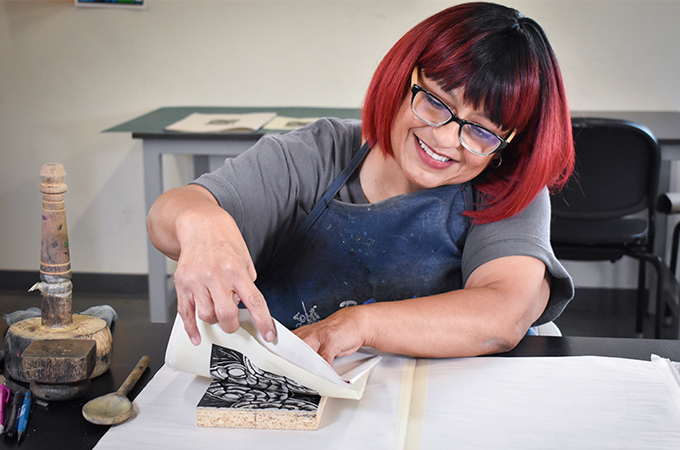Faculty members in the University of Redlands Studio Art Department, who teach courses from advanced graphic design and photography to sculpture and printmaking, are applying some of their creativity to adapting their disciplines to an online modality this semester.
Department Chair Penny McElroy, who is teaching typography and advanced graphic design, says she wasn’t surprised with the decision to hold a virtual fall semester and was already planning to teach courses online. “I was mostly concerned about making sure everyone was safe and wanted to plan for virtual courses so I would be prepared,” she says.
While graphic design courses are easier to translate to a digital learning environment than some other studio art disciplines, McElroy still redesigned her courses and figured out which communication and productivity tools would best suit her students. Using Slack, a communication platform that combines teams and direct messages in a chat room-like setting, she delivers homework assignments and answers questions from students, just as she would during office hours on campus.
McElroy recorded demonstrations of certain techniques and tools to help students understand technical aspects of graphic design. Having a catalog of these recordings, she says, has been a long time coming and something students have asked for in the past.
Making it work
Teaching typography has required more adaptation. “Normally, for typography, I would be teaching with a letter press in the type shop on campus, and we’d have the ability to print things by hand,” she says. “But in this situation, I decided to explore the concepts in a different way. Instead of setting type by hand, students will be drawing letters—using the components of letter forms in artists’ books and to design an original alphabet. So, they’re still learning the same concepts that they would in the on-campus course, that process is just happening at home.”
Professor Anna M. Gaitan agrees that more physical art forms require more adaptation. Ahead of her drawing, 2D design, and printmaking courses, Gaitan has erected makeshift studios in Ann Peppers Hall and has asked her students to do the same in their own homes. Along with distributing pre-recorded demonstrations, she is conducting some live sessions that allow students to follow along with her.
“I am going to work with the same sort of supplies and equipment as my students, rather than working in the printing lab,” says Gaitan. “Overall, my goal is to give them the same quality of information about traditional and modern printmaking, even if the studio experience is different.”
McElroy, Gaitan, and Professor of Photography Tommi Cahill have all spent time thinking about the best way to ensure students are getting the supplies they need. Some professors have utilized a new tool on BLICK Art Materials’ website that allows professors to easily make supply lists, which students can then purchase from. Cahill, who is teaching a first-year seminar on visual storytelling in addition to photography classes, has worked to enhance course textbooks with worksheets she’s designing.
“I realize that budgets are really tight right now,” she says. “Instead of requiring that students buy a photography textbook, I’m designing supplements when I can.”
An emphasis on relationships
In addition to ensuring students grasp the content of each course, the three professors have also devoted time to building relationships with students, albeit through a computer screen. A hallmark of the University of Redlands student experience, professors connecting with students has become even more important in recent months due to the pandemic.
Cahill began interacting with her students during the summer months by creating a chat group on WhatsApp, a digital messaging application. “This incoming class is kind of shy,” she says. “We were able to play games in the chat group and break the ice. In class, groups of students talk about what they find interesting in the course content.”
McElroy agrees: “As a professor and an introvert, I have to have a relationship with my students in order to teach them,” she says. “I’ve devoted time for us to ask each other questions to learn about each other and laugh together. My hope is to open the space to encourage them to relate to the content of the course, but also to each other.”
Greta Jursch ’21, a student in McElroy’s advanced graphic design course, notes that her class sessions and interactions with professors have surpassed her expectations. “Professor McElroy and the art department have seamlessly translated the close-knit Redlands culture we know and love into the online format,” she says. “Our critiques are so constructive and personalized that I sometimes forget we aren’t all together.”
Learn more about studying Studio Art at the University of Redlands.






